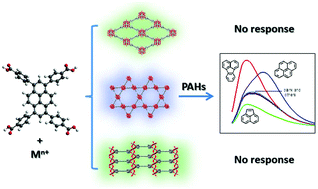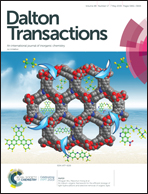Pyrene-based MOFs as fluorescent sensors for PAHs: an energetic pathway of the backbone structure effect on response†
Abstract
The sensing performance of metal–organic frameworks (MOFs), a novel kind of crystalline fluorescent sensing materials, would be profoundly affected by their backbone structures. The current understanding about the backbone effect is limited to the modulation of analyte accommodation through pore structures. Herein, three topologically different pyrene-based MOFs, including NU-1000, NU-901 and ROD-7, were investigated as potential fluorescent sensors for polycyclic aromatic hydrocarbons (PAHs). Although these MOFs are constructed by the same photoactive component, they exhibited distinct sensing behaviors. NU-1000 gave different forms of fluorescent response to acenaphthylene, pyrene and fluoranthene with detection limits at the ng L−1 level. In contrast, NU-901 and ROD-7 were unresponsive to all tested PAHs. Experimental and computational investigations illustrate that this distinction is due to the variance in the excited state energy. The strong inter-ligand interaction in NU-901 and ROD-7 lowers their excited state energy and thus thermodynamically inhibits the photo-induced electron transfer and excimer/exciplex formation, which works in the NU-1000 system. This work proves for the first time that the topological structure of MOFs could affect their sensing performance in an energetic way.



 Please wait while we load your content...
Please wait while we load your content...